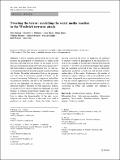Files in this item
Tweeting the terror : modelling the social media reaction to the Woolwich terrorist attack
Item metadata
| dc.contributor.author | Burnap, Pete | |
| dc.contributor.author | Williams, Matthew L. | |
| dc.contributor.author | Sloan, Luke | |
| dc.contributor.author | Rana, Omer | |
| dc.contributor.author | Housley, William | |
| dc.contributor.author | Edwards, Adam | |
| dc.contributor.author | Knight, Vincent | |
| dc.contributor.author | Procter, Rob | |
| dc.contributor.author | Voss, Alexander | |
| dc.date.accessioned | 2015-07-10T12:10:03Z | |
| dc.date.available | 2015-07-10T12:10:03Z | |
| dc.date.issued | 2014-06 | |
| dc.identifier | 192237798 | |
| dc.identifier | e4fec9d3-2469-4469-a7c2-a9ebcf1064cb | |
| dc.identifier | 84906264962 | |
| dc.identifier.citation | Burnap , P , Williams , M L , Sloan , L , Rana , O , Housley , W , Edwards , A , Knight , V , Procter , R & Voss , A 2014 , ' Tweeting the terror : modelling the social media reaction to the Woolwich terrorist attack ' , Social Network Analysis and Mining , vol. 4 , no. 1 , 206 . https://doi.org/10.1007/s13278-014-0206-4 | en |
| dc.identifier.issn | 1869-5450 | |
| dc.identifier.other | Bibtex: urn:839a9f3241c100bdcaa3024a2ced708f | |
| dc.identifier.other | ORCID: /0000-0002-8053-2175/work/31093299 | |
| dc.identifier.uri | https://hdl.handle.net/10023/6962 | |
| dc.description | Date of Acceptance: 23/05/2014 | en |
| dc.description.abstract | Little is currently known about the factors that promote the propagation of information in online social networks following terrorist events. In this paper we took the case of the terrorist event in Woolwich, London in 2013 and built models to predict information flow size and survival using data derived from the popular social networking site Twitter. We define information flows as the propagation over time of information posted to Twitter via the action of retweeting. Following a comparison with different predictive methods, and due to the distribution exhibited by our dependent size measure, we used the zerotruncated negative binomial (ZTNB) regression method. To model survival, the Cox regression technique was used because it estimates proportional hazard rates for independent measures. Following a principal component analysis to reduce the dimensionality of the data, social, temporal and content factors of the tweet were used as predictors in both models. Given the likely emotive | |
| dc.format.extent | 14 | |
| dc.format.extent | 582597 | |
| dc.language.iso | eng | |
| dc.relation.ispartof | Social Network Analysis and Mining | en |
| dc.subject | Social network analysis | en |
| dc.subject | en | |
| dc.subject | Information flows | en |
| dc.subject | Information propagation | en |
| dc.subject | Information spreading | en |
| dc.subject | Social media | en |
| dc.subject | Sentiment analysis | en |
| dc.subject | Opinion mining | en |
| dc.subject | Predictive models | en |
| dc.subject | QA75 Electronic computers. Computer science | en |
| dc.subject | H Social Sciences | en |
| dc.subject | SDG 16 - Peace, Justice and Strong Institutions | en |
| dc.subject.lcc | QA75 | en |
| dc.subject.lcc | H | en |
| dc.title | Tweeting the terror : modelling the social media reaction to the Woolwich terrorist attack | en |
| dc.type | Journal article | en |
| dc.contributor.institution | University of St Andrews. School of Computer Science | en |
| dc.identifier.doi | https://doi.org/10.1007/s13278-014-0206-4 | |
| dc.description.status | Peer reviewed | en |
This item appears in the following Collection(s)
Items in the St Andrews Research Repository are protected by copyright, with all rights reserved, unless otherwise indicated.

